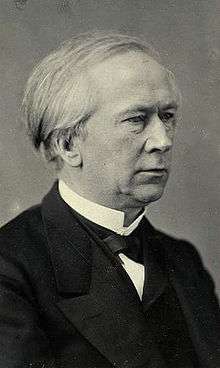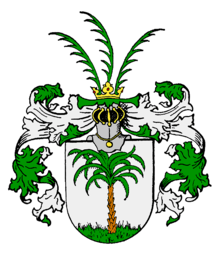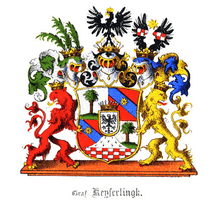Alexander von Keyserling
Alexander Friedrich Michael Lebrecht Nikolaus Arthur Graf[2] von Keyserling[3][4] (15 August 1815 – 8 May 1891) was a Baltic German geologist and paleontologist from the Keyserlingk family of Baltic German nobility.
Alexander von Keyserling | |
|---|---|
 | |
| Born | 27 August [O.S. 15] 1815 Kabillen Manor, Kabillen, Kreis Goldingen, Courland Governorate (in present-day Kabile, Kuldīga Municipality, Latvia) |
| Died | 20 May [O.S. 8] 1891 Rayküll Manor, Rayküll, Kreis Harrien, Governorate of Estonia, Russian Empire (in present-day Raikküla, Rapla County, Estonia) |
| Nationality | Baltic German |
| Citizenship | Russian Empire German Confederation German Empire |
| Alma mater | Humboldt University of Berlin |
| Scientific career | |
| Fields | Geology Botany |
| Author abbrev. (botany) | Keyserl. |


Career
Alexander von Keyserling was born on 27 August [O.S. 25] 1815 at the Kabillen Manor, Kabillen, Courland Governorate (in present-day Kabile, Kuldīga Municipality, Latvia), then part of the Russian Empire. His father was Count Heinrich Diedrich Wilhelm von Keyserling, 3rd Count of Rautenburg, was a spokesman, Kreismarschall and Landbotenmarschall in Courland, his mother was Baroness Anna Amalie Benigna von Nolde. His family was of Westphalian origin and was originated in Herford, they were considered part of the Uradel, or old nobility. The first ever mentioned member was Albert Keserlink (1443-1467 or 1468), the mayor of Herford. Alexander belonged to the House of Rautenburg-Telsen-Paddern,[5] which was a subdivided branch of the Prussian comital branch.[6] The branch's founder Dietrich II von Keyserling, Herr auf Okten und Ligutten, was elevated to count in 1786.[7] Dietrich's father Heinrich Christian also inherited the title of Count of Rautenburg,[8] although Alexander didn't inherit the title since he was the 10th child in the family, his elder brother Otto Ulrich Johann inherited the title.[9]
Alexander studied at the Humboldt University of Berlin, here he met with future German Chancellor Otto von Bismarck and John Lothrop Motley, whom he became lifelong friends.
Alexander is considered to be one of the founders of Russian geology. He made many expeditions on behalf of Nicholas I of Russia in Estonia, northern Russia, and the Urals (1839-1846).[10]
He was also a botanist and zoologist who wrote Die wirbelthiere Europa's (Vertebrates of Europe) with Johann Heinrich Blasius. This work was published in 1840.[11]
Alexander's nephews include diplomat Heinrich von Keyserlingk and writer Eduard von Keyserling. Archibald von Keyserling, the first leader of the Latvian Navy, was his brother Eduard Ernst Hermann von Keyserling's grandson. Philosopher Hermann von Keyserling was his grandson.
Evolution
Keyserling was an advocate of the transmutation of species. In 1853, he wrote an article which suggested that species arose from the activity of "alien molecules" acting on the embryo. He believed that such molecules were transported by miasma.[12] In the third edition of On the Origin of Species published in 1861, Charles Darwin added a Historical Sketch that acknowledged the ideas of Keyserling.[12][13]
Darwin sent a copy of his book to Keyserling who was skeptical about the role of natural selection in evolution.[12] By 1886, however, he embraced most of Darwin's ideas claiming "I renounced my views which contradicted Darwin's theory, and I consider that the changes of the embryo arise not by means of external action of certain molecules but by the influence of selection and heredity."[12]
Legacy
Keyserling is commemorated in the scientific name of a species of gecko, Teratoscincus keyserlingii.[10]
See also
References
- Carl Arvid von Klingspor (1882). Baltisches Wappenbuch. Stockholm. p. 157. ISBN 978-0-543-98710-5. Retrieved 11 May 2019.
- Regarding personal names: Until 1919, Graf was a title, translated as Count, not a first or middle name. The female form is Gräfin. In Germany since 1919, it forms part of family names.
- His full name was stated as Alexander Friedrich Michael Lebrecht Arthur Nicolaus James in the Curonian edition of the Baltic Knighthood book.
- Stavenhagen 1930, pp. 241.
- Stavenhagen 1930, pp. 139.
- Stavenhagen 1930, pp. 138.
- Satvenhagen 1930, pp. 121.
- Stavenhagen 1930, pp. 132.
- Stavenhagen 1930, pp. 140.
- Beolens, Bo; Watkins, Michael; Grayson, Michael (2011). The Eponym Dictionary of Reptiles. Baltimore: Johns Hopkins University Press. xiii + 296 pp. ISBN 978-1-4214-0135-5. ("Keyserling", p. 140).
- Keyserling A, Blasius JH (1840). "Die wirbelthiere Europa's". Hathi Trust Digital Library. Braunschweig: F. Vieweg und sohn. Retrieved 15 August 2016.
- Rogers, James Allen (1973). "The Reception of Darwin's Origin of Species by Russian Scientists". Isis 64 (4): 484-503.
- Darwin C (1861). The Origin of Species. Preface to the Third Edition.
- IPNI. Keyserl.
Sources
- Otto Magnus von Stackelberg (1930). Genealogische Handbuch der baltischen Ritterschaften. Teil Estland, Band I. Starke Verlag, Görlitz. pp. 140–144. Retrieved 10 May 2019. (de)
- Oskar Stavenhagen (1930). Genealogische Handbuch der baltischen Ritterschaften. Teil Kurland, Band II. Starke Verlag, Görlitz. pp. 118–149. Retrieved 10 May 2019. (de)